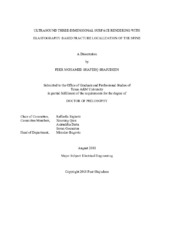| dc.contributor.advisor | righetti, raffaella | |
| dc.creator | Shajudeen, Peer Mohamed Shafeeq | |
| dc.date.accessioned | 2020-09-09T18:26:45Z | |
| dc.date.available | 2020-09-09T18:26:45Z | |
| dc.date.created | 2018-08 | |
| dc.date.issued | 2018-08-09 | |
| dc.date.submitted | August 2018 | |
| dc.identifier.uri | https://hdl.handle.net/1969.1/188953 | |
| dc.description.abstract | Ultrasound (US) has recently emerged as an attractive imaging modality for applications like
accurate epidural placement and intraoperative guidance during surgeries. However, operators like
anesthesiologists or surgeons untrained in US have difficulty interpreting the anatomy in noisy
spinal US images. This problem is exacerbated by presence of fractures which is integral to the
assessment of spinal cord injuries and stability. A method to automatically isolate and perform a
3D rendering of the spine anatomy from scanned US images is proposed. In the case of fractures,
ultrasound elastography techniques are proposed by assessing the mechanical response to a
uniaxial compression at the posterior vertebra-soft tissue boundary.
Experiments are performed by scanning the lumbar and thoracic vertebrae of 17 healthy volunteers
BMI ranging from 19.5 to 27.9. A local phase-symmetry technique is applied to the US B-mode
images for enhancement of bone-like ridges and the spine blobs are subsequently classified. The
segmented spine surface from the blobs is compared against the radiologist’s manual delineation
of the spine surface. This performance assessment analysis is also consequently extended to 3D
surfaces. For investigating spine fractures, experiments are performed on ex-vivo rabbit lumbar
spine samples. 3D finite element models of the vertebra-soft tissue complex are generated to
simulate axial normal and shear strains. Also, experiments on the same samples are performed to
corroborate simulation findings. The numerical characteristics of axial strain’s spatial distribution
are further used to construct two shape descriptors to make inferences on spinal abnormalities.
The proposed techniques accurately generate a 3D surface rendering of multiple vertebrae
specifically showing landmarks like the laminae, ligamentum flava, spinous, transverse and
articular processes. These techniques are also extended for bone regeneration applications which
has implications for the monitoring of postoperative bone healing. Results from studies on spine
fractures indicate that the disruption of axial strains manifest as distinct patterns around intact and
fractured vertebrae. These along with the shape descriptor features resulting from the surrounding
soft tissue deformation can serve as a useful adjunct to B-mode images in uniquely determining
the location of fracture sites. | en |
| dc.format.mimetype | application/pdf | |
| dc.language.iso | en | |
| dc.subject | ultrasound | en |
| dc.subject | segmentation | en |
| dc.subject | elastography | en |
| dc.title | Ultrasound Three-Dimensional Surface Rendering with Elastography-Based Fracture Localization of the Spine | en |
| dc.type | Thesis | en |
| thesis.degree.department | Electrical and Computer Engineering | en |
| thesis.degree.discipline | Electrical Engineering | en |
| thesis.degree.grantor | Texas A&M University | en |
| thesis.degree.name | Doctor of Philosophy | en |
| thesis.degree.level | Doctoral | en |
| dc.contributor.committeeMember | qian, xiaoning | |
| dc.contributor.committeeMember | datta, aniruddha | |
| dc.contributor.committeeMember | goenezen, sevan | |
| dc.type.material | text | en |
| dc.date.updated | 2020-09-09T18:26:45Z | |
| local.etdauthor.orcid | 0000-0002-5898-5258 | |


